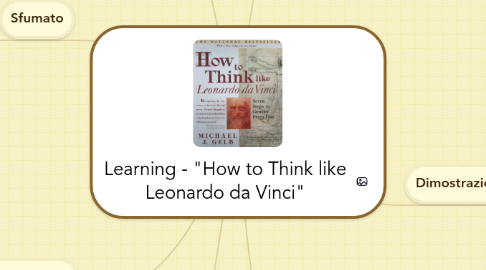
1. Connessione
1.1. Connessione = A Recognition and Appreciation for the Interconnectedness of All things and phenomena. Systems thinking.
1.2. Have multiple attitudes towards something you're doing
1.3. Remember that everything is connected in one way or another
1.4. Remember that everything paints a bigger picture
1.4.1. Understand how things are connected and how they change accordingly
1.5. There is a connection between everything
2. Sfumato
2.1. Sfumato = (Literally "Going up in smoke") A willingness to embrace Uncertainty, Ambiguity and Paradox.
2.2. Keeping your mind open in the face of uncertainty. Remember that nothing is impossible (general idea)
2.3. Don't limit your choices within a box
2.3.1. See creativity and possibility within confusion and ambiguity
2.4. Don't think you know what you know because the more you know, the more you do not know
2.5. Nurture Sfumato by taking time for solitude and relaxation
2.5.1. Taking breaks to renew your perspective.
2.5.2. "The spaces between your conscious efforts provide a key to creative living and problem solving. These spaces allow perceptions, ideas, and feelings to incubate."
2.6. Trust your instincts
3. Arte & Scienza
3.1. Arte & Scienza = The development of the balance between Art and Science, imagination and logic. Practicing "whole-brain" thinking.
3.2. Art and science should complement each other.
3.3. "Be sure you know the structure of all you wish to depict"
3.4. See the infinite possibilities in anything
3.5. The process of our thought should be balanced between Arte and Scienza. Mind maps can train us to think in a more balanced way
4. Corporalita
4.1. Corporalita = The cultivation of Grace, Fitness, Ambidexterity and Poise.
4.2. Our health and well-being is our own responsibility
4.2.1. A few important factors of the many that affect our health: Diet, posture and mood
4.3. Our potential for consciousness and intelligence is linked to the evolution of our fully upright stature
4.4. An incorrect posture affects your health. Likewise, the correct posture maintains it
4.5. Alexander technique
4.6. Cultivating ambidexterity
4.7. Seek to improve your mind-body coordination
5. Curiosita
5.1. Curiosita = An Insatiably Curious approach to Life and an Unrelenting quest for Continuous Learning.
5.2. Convert your passion for specific things into curiousity
5.3. Observation is necessary to understand something
5.3.1. Curiosity should be fulfilled from multiple perspectives
5.3.2. Choosing and working with a theme is a powerful tool for focusing
5.4. Contemplation helps to reach a better understanding of things and gain more ideas from observation
5.5. Use the "Stream of Consciousness" writing technique to gain interesting insights from seemingly irrelevant nonsense
5.6. Curiosita can start with a curiosity for anything. Looking at a subject from different perspectives and ask many questions.
5.6.1. Ask yourself "What is the right question?" Re-framing or rephrasing the question will help place ourselves in multiple perspectives.
5.6.2. Ask questions that you have never asked before
5.6.3. Ask questions based on a seemingly simple and naive direction. We tend to overlook useful information as useless, little details
5.6.4. 5Ws and 2Hs: Add dimensions to your questions to adjust the depth and perspective of a question
5.6.5. Use the "why-why" technique to get to the depths
5.7. Curiosita at work
5.7.1. The happiest people in the world ask, "what if I could find some way to get paid for doing what I love?"
5.8. Ask yourself these questions while dealing with your Curiosita (through habits, lifestyle or an ideal hobby)
5.9. Create your own lexicon - Knowing more words means that you can use a wider range of descriptions for curiosta and other things
5.10. Asking for feedback provides more perspectives of understanding on a subject and a chance for you to reflect
5.10.1. Take note of the responses you get. Accept them and reflect on them. Don't expect a certain reaction
6. Dimostrazione
6.1. Dimostrazione = A Commitment to Testing Knowledge through Experience, Persistence and the Willingness to Learn from Mistakes.
6.2. "A good teacher is a teacher that has the ability to teach the student to learn for himself"
6.3. The world is vast, look for inspirations around you, especially in nature
6.4. Study works of others critically and determine their validity with personal experience
6.5. "experience never errs; it is only your judgement that errs in promising itself results that are not caused by your experiments." -Leonardo da Vinci
6.6. Reflect why your thoughts influence the way you think and act
6.7. Look at a point from at least 3 perspectives
6.8. "Awareness, deep contemplation and a good humor are your best friends in attempting to learn from difficult experiences."
6.9. Learn from other people's mistakes instead of making those mistakes yourself
7. Sensazione
7.1. Sensazione = The continual Refinement of the Senses, especially Sight, as the means to Enliven Experience.
7.2. Sight
7.2.1. Are you using your eyes to their full ability?
7.2.1.1. Look at different sceneries; describe your surroundings, the way they look, move and occurring interactions
7.2.1.2. Take care of your eyesight
7.2.2. Practice visualization
7.2.3. Learn to draw
7.3. Smell
7.3.1. Be able to discriminate between different smells
7.3.1.1. A larger vocabulary would help to describe a range of smells
7.3.2. Try to ascertain the source of a smell
7.3.2.1. Relate the smell of an object to its appearance, feeling and characteristics
7.4. Touch
7.4.1. Notice your sense of touch when you feel different surfaces and objects
7.5. Hearing
7.5.1. Practice listening to your surroundings
7.5.2. Practice listening to silence
7.5.3. Practice active listening
7.5.3.1. Know what you hear
7.5.3.2. Recognize the presence of emotion
7.5.3.3. Be able to discriminate between different sounds
7.6. Taste
7.6.1. Understand what you eat and how they really "taste"
7.6.2. Train your sense of taste with comparative appreciation
7.6.2.1. Trying different kinds of variations of the same food
7.7. Synesthesia
7.7.1. Try combining the use of different senses
7.7.1.1. Draw a sound
7.7.1.2. Sculpt music
7.7.1.3. Sing a tune or note for a color you like
7.7.1.4. Cook and adjust a recipe
